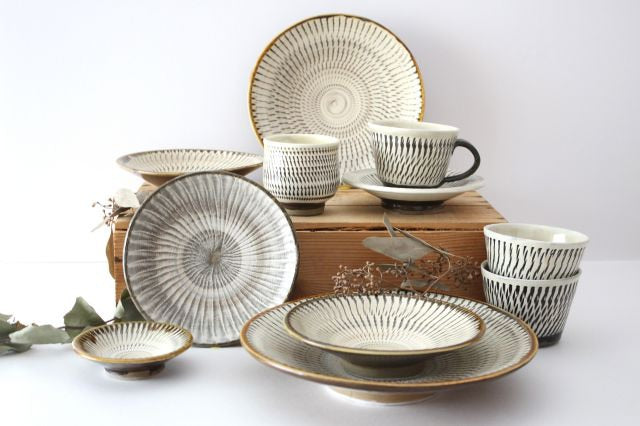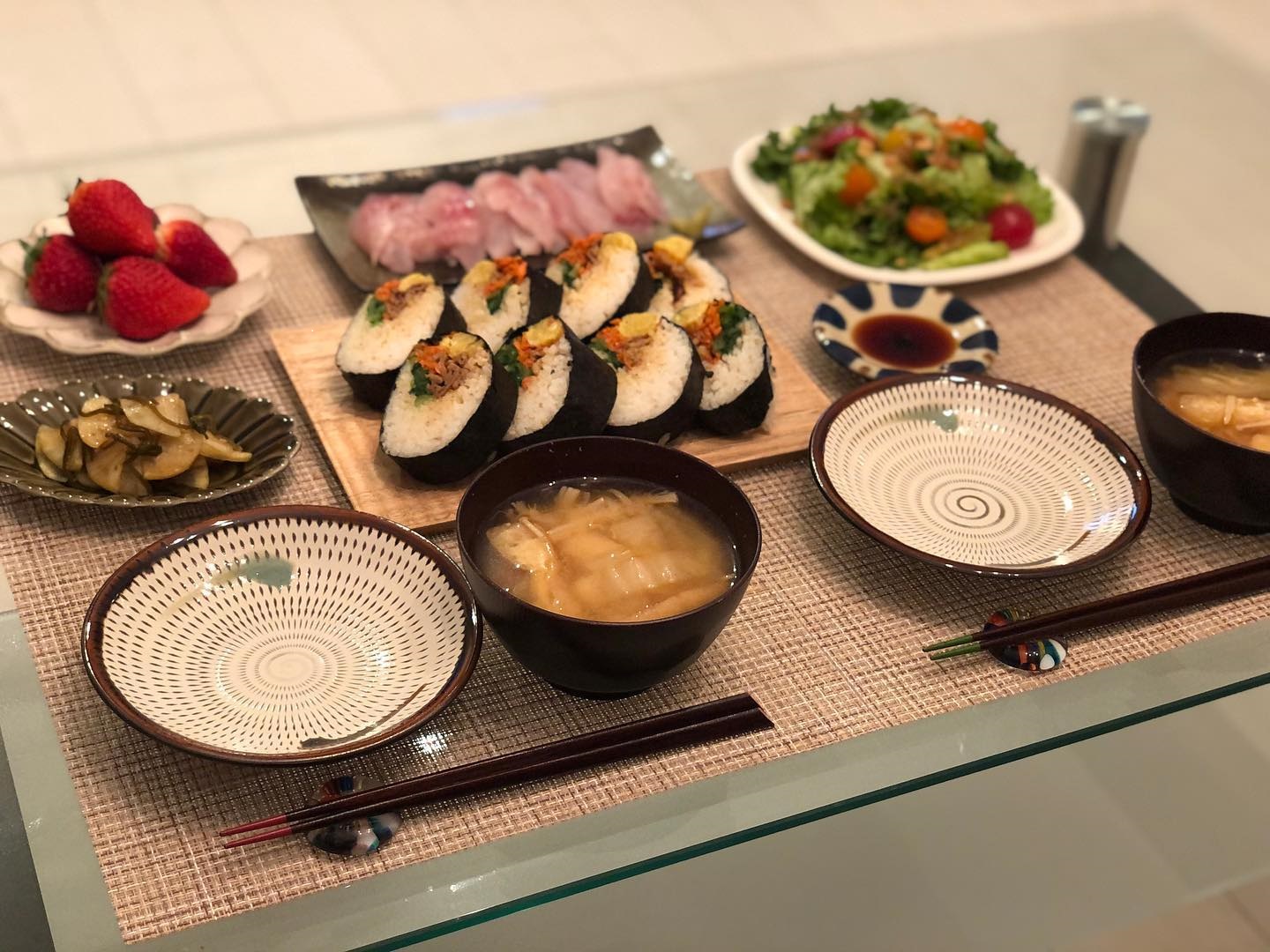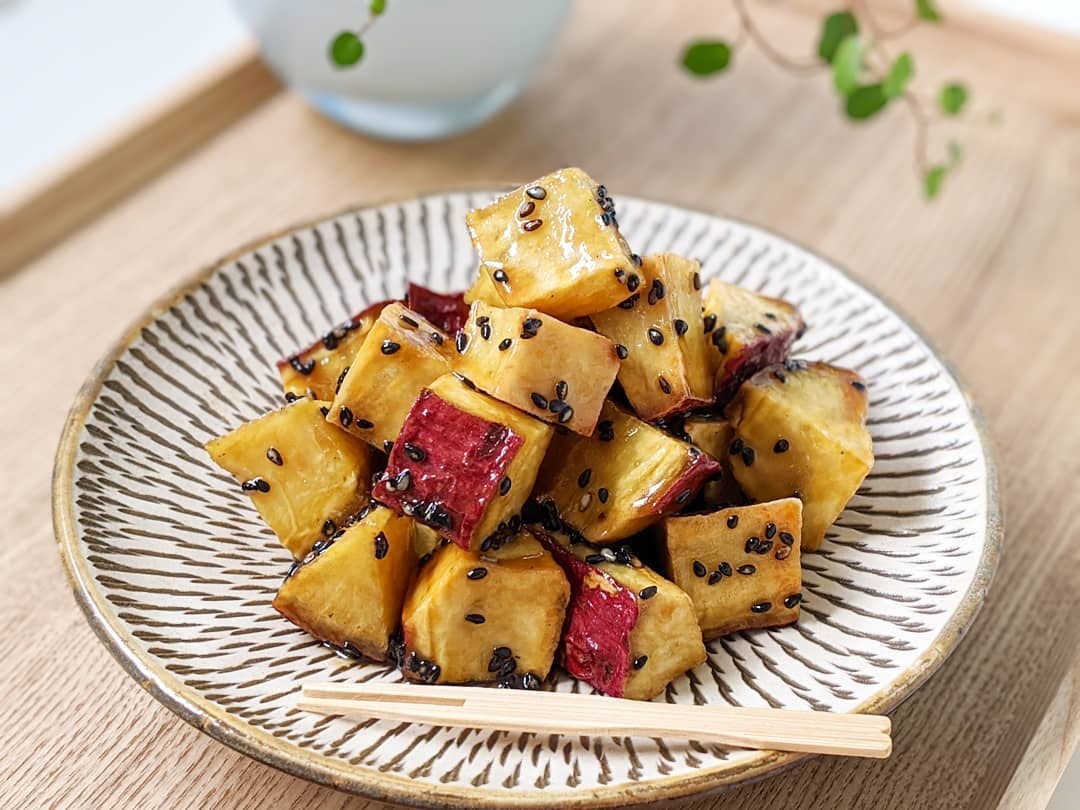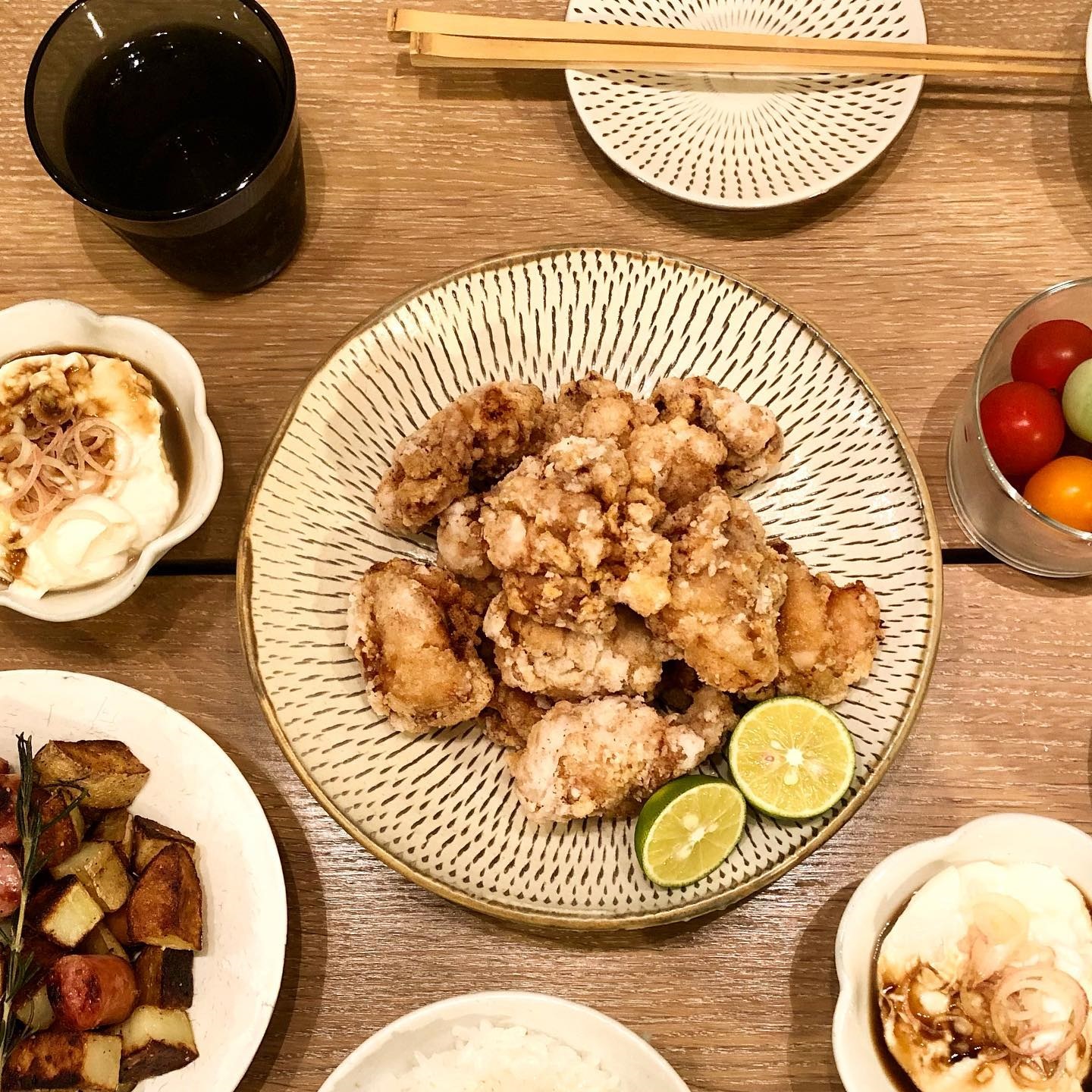Hello, this is Taki from UTSUWABI.
With the recent folk craft boom, Ontayaki and Koishiwara ware are slowly and steadily gaining popularity.
You can often see them lined up at lifestyle shops, or on the Instagram accounts of people who love pottery and cooking.

This time, we will talk about Ontayaki and Koishiwara ware
1. Simple characteristics,
2. Recommended products and potteries,
3. Folk craft boom and history of
Ontayaki and Koishiwara ware. I would like to introduce it to you in three major ways.
What is Ontayaki and Koishiwara ware?

Ontayaki
Ontayaki is a traditional pottery that has been passed down for 300 years in the mountains of Hita City, Oita Prefecture.
Techniques are passed down from parent to child through a hereditary system.
There are only nine kilns today,
all of which have inherited the same flow from when the kilns first opened.
As time passes and mechanization progresses in other production areas, Ontayaki uses nearby mountain soil as its raw material, borrows the power of the river, and carefully carries out all processes with the participation of the entire family. This is done only by hand.
It features a modern and interesting geometric pattern, and when you hold it in your hand, you can feel the plump texture and warmth that can only be expected from clay and handmade products.

One of the joys of choosing Ontayaki is that because it is handmade, no two pieces are the same.
The reason why it feels so warm in your hands and how it naturally blends into your daily life is because it has a long history and tradition.
Koishiwara ware

Koishiwarayaki is the root of Ontayaki, and is also called the "brother kiln."
The kiln opened a little earlier than Ontayaki in Toho Village, Asakura District, Fukuoka Prefecture (formerly Koishiwara Village), and has continued for about 350 years.
There are currently over 50 potteries.
Like Ontayaki, while ensuring that traditional techniques such as
"Tobikanna" and "Hakeme" are preserved, we incorporate designs that are more suited to modern eating habits.
Evolving Koishiwara ware is proposed by each pottery based on its own ideas, and it is likely that you will be able to find one that suits your lifestyle.
Rhythmic and modern geometric patterns
One of the most distinctive features is the rhythmic and interesting geometric patterns carved into the vessels.
Tobikanna Hakeme
Hakeme

This pattern is a traditional decorative technique called "Tobikanna" or "Hakeme".
Each piece is carefully drawn by a potter using a plane and a brush.
Although simple, these patterns exquisitely
complement ordinary dishes.

It can be used as a main dish due to its unique presence, or as a supporting dish due to its simple and calming
colors.
Great compatibility with other utensils.
The best part is enjoying the tasteful expression that can only be achieved by hand.
It's easy to use, so it
will appear more often.
Recommended Ontayaki and Koishiwara ware
From now on, I would like to introduce some recommended products from Ontayaki and Koishiwara ware.
Onta-yaki and Koishiwara-yaki may seem similar, but if you look at them like this, you'll find that there are quite a few differences.
Ontayaki that blends into daily life
Round Plate Tobikanna 21cm/8.3in | Ontayaki

The versatile 7-inch plate is a size that is often used throughout the day.
Easy to serve with stir-fried vegetables or pile up croquettes for 2 to 3 people.
The edges are slightly raised,
so you can safely use it even with slightly juicy foods such as beef stew and curry.
Rice Bowl Tobikanna | Ontayaki

A 4-inch rice bowl that is just the right size to eat.
Not only does it go well with freshly cooked white rice,
but it goes well with green pea rice as well, as it has a soft white background.
This is a slightly shallow rice bowl with a large diameter.
Round Plate Hakeme 18cm/7.1in | Ontayaki

A 6-inch plate with a "Hakeme" decoration that gives it a mysterious taste.
It's a versatile size and will be
used many times throughout the day.
Chinese stir-fried vegetables with plump shrimp as a side dish for lunch.
For dinner, you can also spread out
shiso leaves and top with steamed chicken salad.
Hot water cup Tobikanna

The comfortable size of the teacup fits perfectly in both hands, and its soft impression blends in with your everyday dining table.
It has a cute shape with a slightly glossy surface and a constriction at the top.
The unevenness of the
tobikanna is a nice accent, and you can enjoy its texture.
Coffee cup Hakeme

A cup and saucer with an impressive "Hakeme" pattern.
The tulip-like shape is charming.
You can also use it as a dessert cup by adding shiruko (shiratama dumplings) or almond tofu.
From the hectic
morning to the relaxing snack time, you'll be able to enjoy your time to the fullest.
Expressive Koishiwara ware
Marudon Tobikanna/Kushime

This is a round bowl with an impressive dotted pattern of Tobikanna and wavy combs.
Today, let's make a quick bowl of rice.
As soon as you step into the plump, round bowl, your appetite will be
whetted.
5-inch plate Tobikanna

This is a 5-inch plate with an impressive dotted pattern of "Tobikanna" and a pattern drawn with two colors of glaze.
Put some light snacks such as rolls or rice balls on top.
During snack time, just putting Japanese sweets or
cream puffs on top will make a great picture.
4-inch plate Tobikanna

A fascinating tobikanna pattern that mysteriously matches a wide range of cuisines, including Japanese, Western, Chinese, and ethnic.
The size makes it useful as a snack plate for placing steamed buns and cookies.
The edges are slightly raised,
so it's great for serving as a juicy side dish.
Popular pottery for Ontayaki and Koishiwara ware
Oumei Kamamoto

"The more you use it, the more you will love it, and the more you will enjoy your daily life."
Omei Onimaru and
his son Naoyuki create pottery every day with this in mind.
While using clay from Koishiwara and carefully preserving the inherited decorative techniques, the duo's new ideas are everywhere, such as adding dot patterns and creating a matte texture, all inspired by the user's dining table. It shines.
A popular pottery that combines both tradition and modern sensibilities.
Keishigama

Keishigama is a wonderful kiln with a unique form that makes you feel playful while taking advantage of the goodness of Takatori ware.
Unique motifs such as birds, acorns, and cups are decorated with traditional Koishiwara ware patterns such as hakeme and tobikanna.
These pots are beautiful to look at, easy to use, and have a lot of craftsmanship in them.
Marutagama Ota Gosoku Koishiwara ware

Marutagama produces pottery that combines traditional Koishiwara ware techniques such as brush patterns and flying planes with cuteness such as tricolor patterns.
He uses the pottery clay of Koishiwara, where he was born and raised, to create pottery that decorates modern dining tables.
Although it has a nostalgic feel, it naturally matches modern life.
Hayakawa Pottery Hidetami Hayakawa

Using the special techniques of Koishiwara ware, such as the flying plane and brush marks, the pottery is created with the aim of creating pottery that is easy to use, gentle, and offers gentle tableware while still having a traditional pattern. .
A pottery that is both comfortable to use and beautiful.
Yamaru kiln

Yamaru Kiln creates pottery every day, using traditional techniques and using nature as a motif, in search of individuality.
Works with acorn and bird motifs will make you say "so cute!" and will bring a fun atmosphere to your dining table.
Marudaigama Manya Ota

Users are made with great care, created in new shapes, used by their families, and improved upon.
While
preserving the glaze making and techniques that have been passed down from generation to generation, they create
pottery that is fun to look at, fun to use, and happy to give as a gift.
The rustic atmosphere complements the dishes and blends naturally into your everyday dining table.
Moriyama Kanzan Kiln

Utsuwa wares are characterized by unique patterns created using the traditional techniques of Koishiwara ware: tobikanna, hakeme, and nagagake.
While inheriting tradition, it has a somewhat modern atmosphere, and has an art-like beauty.
Kurado pottery

Since the pottery is used every day, he strives to make pottery that is light and easy to use, and he is constantly creating new pottery while preserving the traditions of Koishiwara ware, such as the flying plane and brush.
Although it is simple, it gently enhances the food, so it has a charm that makes you want to pick it up.
Koishiwara Pottery

A brand created through a collaboration between 10 potteries in Koishiwara and Tomoko Nagao, a food coordinator who is active in magazines.
As the theme is "Utensils that make food delicious," it is very popular among Deliista glamour.
Ontayaki/Koishiwara ware techniques

The traditional decorative techniques that are synonymous with Ontayaki and Koishiwara ware are "Tobikanna" and
"Hakeme."
When you look at it from above, you can clearly see the interest and expression of the pattern.
It is this modern and historic decoration that makes any dish look gorgeous, even though it is simple.
Craftsmen
apply with skill using planes and brushes.
Tobikanna

"Tobikanna" is a technique in which continuous incisions are made using a resilient metal tool.
It will be completed in no time.
When you attach a plane to a pottery that is spinning on a potter's wheel, a
simple, geometric, and mysterious pattern instantly appears.

Depending on the pottery, it can look like a stylish modern pattern.
Hakeme

"Hakeme" is a technique of applying white makeup soil with a brush.
Again, the pottery is placed on the potter's wheel and the pattern is drawn using a brush.
If you place the center of the container as the axis, you will create an elegant pattern that looks like a
chrysanthemum flower.

Other methods include "comb-drawing", in which wavy curves are drawn with a comb-like tool, "finger-drawing", in which
wavy curves are drawn quickly with fingers, and "uchikake", in which patterns are created by putting glaze in a ladle
or dropper.
There are also techniques such as "nagagake".

Although it is a simple continuous pattern, it is interesting to see how different expressions can be created
depending on the pottery.
If you compare the different finishes made by each potter, you will become more and
more attracted to their charm.
History of Ontayaki and Koishiwara ware
History of Koishiwara ware
In 1665, the second generation of Takatori ware, which opened a kiln in Fukuoka Prefecture, found high-quality clay in the Koishiwara area, opened a kiln, and began firing mainly tea pottery.
Later, the third generation lord of the Chikuzen Fukuoka domain invited potters from Imari from the Hizen domain to teach them the manufacturing method of porcelain, and by interacting with the Takatori ware kiln, it is said that the prototype of Koishiwara ware, which continues to this day, started. I am.
From the Meiji period to the early Showa period, large pots, plates, jars, mortars, etc. were mainly produced in
communal climbing kilns.
Bernard Leach, Muneyoshi Yanagi, Shoji Hamada, and others visited and praised the work.
This brought me into the
spotlight.
With the folk craft boom, the number of people visiting the village in search of Koishiwara ware has increased, and as the kilns, which were previously hereditary, have attracted talent, the number of kilns has increased to more than 50, and traditional techniques have been passed down to the present day.
History of Ontayaki
It is said that in 1705 in the middle of the Edo period, a man named Jubei Kuroki invited potters of Koishiwara ware to Onta Sarayama and built a climbing kiln.
For this reason, it is said to be a sister kiln to Koishiwara ware.
The roots of Ontayaki were actually
Koishiwara ware.

Surprisingly, the method of passing down Ontayaki is a hereditary system in which the technique is passed down from
parent to child.
For a long time, the techniques did not spread outside of the village, and the pottery used in
daily life was made using reliable techniques by generations of potters.
Today, only four surnames, Yanase, Kuroki, Sakamoto, and Obukuro (Kuroki family), which have descended from the tradition 300 years ago, still have kilns.
Ontayaki, which was produced quietly in a secluded mountain village, suddenly became famous after a visit by Muneyoshi Yanagi in 1933.
Soetsu Yanagi was the leader of the Mingei movement that was booming at the time.
The Mingei Movement is a
movement that shines a light on the beauty of everyday tools made by anonymous craftsmen.
Soetsu Yanagi, who visited this village, described Ontayaki as "the best folk pottery in the world" in his travelogue, and introduced Ontayaki to the whole country.

Then, internationally renowned British potter Bernard Leach also stayed for about three weeks.
By praising
Ontayaki's villages and landscapes, its name became increasingly well-known throughout the country.
In 1971, it was designated as a national important intangible cultural property.

Current status of Ontayaki
Ontayaki is said to be a national treasure because it is made by hand, not by machines, and with the help of nature, which has remained virtually unchanged for 300 years.
While mechanization is progressing one after another in other production areas, all processes here are done by hand with the participation of the whole family.

Men have traditionally done the heavy lifting such as preparing the clay, while women have been responsible for
creating the patterns.
It seems that when there was a shortage of manpower, it was natural for people to help
and support each other within the village.

The raw materials are also traditionally produced locally for local consumption.
We use the surrounding soil to
make potter's clay.
It is crushed using a moving mortar using clear stream water.
Of course, after the pottery is shaped and decorated by the hands of a potter, the firing is not done by a machine.
It is baked in a traditional climbing kiln for about two and a half days using firewood procured from the
surrounding mountains.
Two to three days later, when the cold pots are removed from the kiln, they arrive at our hands.

“Gee-go-ton, ge-igo-ton.”
Even now, 300 years later, the sound of a mortar pounding the soil still echoes in the
village, just as it did back then, and you can still see the careful crafting of each pottery.
This pleasant sound has been selected as one of the "100 Japanese sounds".

While some things remain unchanged, Ontayaki has been made into items necessary for daily life in accordance with each
era.
That's why it continues to be used at modern dining tables.
Onta/Koishiwara pottery market
If you want to enjoy more of the charm of Ontayaki and Koishiwara ware, the best way is to visit the area.
You can feel the atmosphere of a pottery village that can only be found here.
Especially at the pottery market, all potteries sell their pottery directly.
There are various kinds of pottery
lined up in the village.

Ontayaki folk pottery festival
The Ontayaki Folk Pottery Festival is held on the second weekend of October every year at the Ontayaki village deep in the mountains of Hita City, Oita Prefecture.
The works baked by nine potteries for this day will be lined up in their workshops, eaves, and storerooms.
It is said to be a festival to thank the kilns that have worked for the past year and to pray for the development of Ontayaki.
Location: Ontayaki no Sato (Sarayama, Genei-cho, Hita
City)
Koishiwara ware autumn folk pottery village festival
The village's approximately 50 potteries are opening their kilns all at once, and the products are being sold at lower prices than usual.
The Koishiwara Pottery Traditional Industry Center holds events such as the sale of new rice balls and a painting experience, making it very lively.
Location: Higashimine Village, Fukuoka Prefecture (Koishihara Ware Ware Traditional Industrial Hall)
How to enjoy pottery cities
In pottery, you can buy it cheaper than the regular price, or get outlet products at a special price.
In addition, there is a lot of real pleasure for the day, which is not usually open to the public, and the scenery of the container is completed.
As you go around the venue, you can encounter unexpected bargains and new potters that you did not know before.
Please look for one of your favorite pieces while comparing the individuality of each kiln.
Stylish table coordination of Ogata ware and Koishihara ware

Koishihara ware of Koishihara ware on a plate.
The way of matching the wooden container and the chimmon is very fashionable.
Tobikanna is easy to match with other containers, and the table coordination is crisp.

Japanese dishes like Japanese dishes are outstanding Japanese sweets.
The yellow of sweet potatoes stands out, and it seems that your hands will not stop during the snack time.

Serve more dishes such as fried chicken.
The warm expression of the depression seems to carry a calm time to the dining table where everyone is surrounded.
Summary
Ogada ware has been inherited from parents to children for about 300 years in the mountains of Oita Prefecture.
The pottery is unusual nationwide, and now 9 kilns are performed in the local production for local consumption, and
all processes are performed by traditional manual work.
Koishihara ware in Fukuoka Prefecture, which is said to be the roots of Ogada ware, is also gaining popularity, while protecting traditions.
Traditional decorative techniques such as "Tobikanna" and "Hake Meme", which are common to these two, create a simple but modern geometric pattern, and match any dishes such as Japanese, Western and ethnic. there is.
Why don't you add Ogata -yaki and Koishihara ware to one of the dining table, which blend in your life naturally and complement various dishes?
Uchi handles Ogata ware and Koishihara ware that are active in various situations, from large plates to bowls, teacups, teacups, cup & amp; saucers.
In addition, you can see the article that the Editorial Bureau actually visited Koishihara.
A pottery tour where you can feel the beauty of your skin in Koishihara
Thank you for watching until the end. I hope you all find good works!
Here is the link to the UTSUWABI website